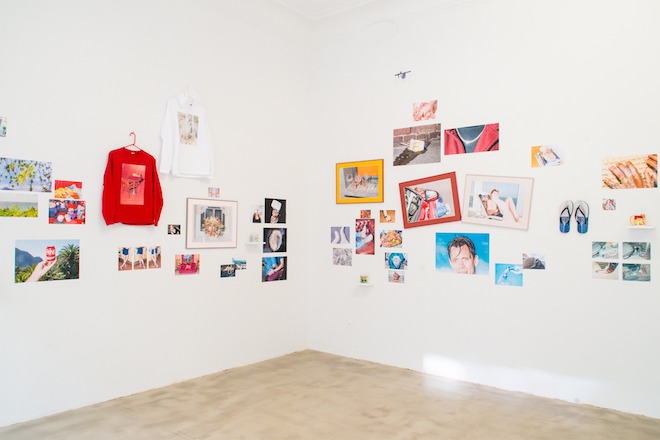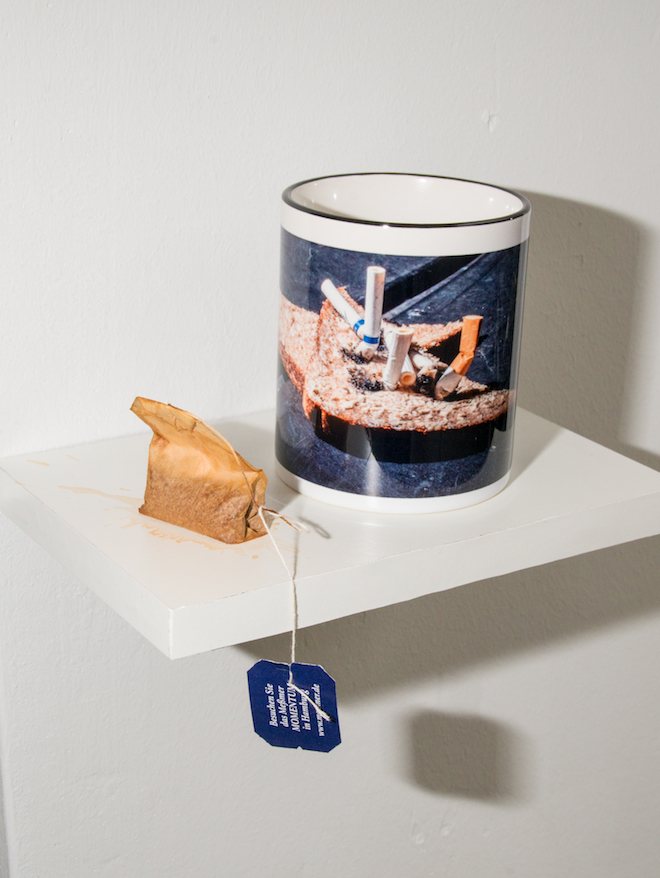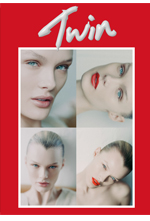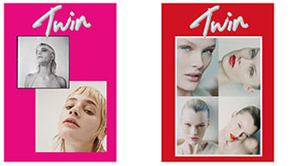Absurd and a little bit off, but always funny. Alexander Coggin excels in the art of tender parody. This February he shows a broad range of photographs in his largest exhibition yet.
Whether it’s spending 48 hours with Gigi Hadid, snapping pictures of the supermodel being hand fed b12 drops by her mother, taking photos of Frieze art fair visitors’ clavicles, or documenting the colourful country club lives of his midwestern inlaws; Alexander Coggin always finds the absurdity in every situation. With warmth and curiosity he unveils the soft underbelly of any desirable lifestyle.“That image of Gigi with the drops is more telling than anything that you’re going to get from a staged photograph,” Coggin explains, “it says a lot about the relationship between her and her mom, Yolanda. It’s beautiful and funny and bizarre and tender in a way.”
The current exhibition, “Yeah, Magic” at Ninasagt Galerie in Düsseldorf is vast, over a 100 photographs framed and unframed in all shapes and sizes. There are images printed on mugs, clocks, sweatshirts – and on a delightfully ridiculous pair of flip flops.
Over the years Coggin has become known for his personal mix between street and still life photography, a colourful aesthetic and his unique sense of humour. His pictures capture the moments in-between perfection, and they almost exaggerate the flaws and quirks of each subject. But instead of being exploitative or down right mean – a not uncommon thing in the world of street photography – the pictures are loving and relatable. And a great way to ward off any incipient social media depression.
There is something very liberating with an old lady arm purposefully hovering over a large plate of shrimp or the low key eroticism of a gear shift. Most of all it is fun. “I think my most successful images incorporate the full human-ness that live art and theatre give you. It takes the character, the specificity of the situation, the personas we see and don’t see about ourselves and filters all of that into a single still image. At best, my work is very much alive.”

Yeah Magic © Alexander Coggin
Every article ever written (this might not be entirely true) about Alexander Coggin mentions theatre in some way – you have to. It it his one main influence and his educational background. It is also, in an unexpected way, the reason he found and fell in love with photography. Coggin and his husband moved to Berlin in 2011 to take part of the then booming theatre and performance scene. But the complexity of making and acting in theatre became overwhelming.
– After leaving the structure of school I realised that making theatre is such a collaborative process. You need to find a production, a director, a piece of work, a house that can mount the production. My creativity became stagnant. I got into photography as a way to release this pent up creativity in a solo way, beholden to none other. I really started to enjoy Photography when I realised that I could bring the things I love about theatre into the work. It was an antidote, a therapeutic transformation.
Do you think you’re going to go back to the theatre at some point?
– I think so. I still enjoy the binary of live arts vs. still imagery – it’s either one or the other. I think that ultimately, they’ll both come together in filmmaking. That’s the natural progression, but I don’t want to rush this because I want to do it in a way that feels authentic to my eye and my interests.
Your images are often quite raw and people show sides of themselves that you usually don’t see. How do you make the subject feel so comfortable?
– There are a couple of ways to get these authentically voyeuristic shots. The work I’ve done with my husband’s family [Brothers and Others], for instance: Because they are my family, I’m comfortable around them and they don’t change their behaviour when I shoot. It took years to get to that point. When I spend a couple of weeks with them I take thousands and thousands of images, that’s all edited into a finite body of work. I get lucky in terms of numbers. And time.
And when you do a project like the one with Gigi, when you only had a certain amount of time?
– If I have a commissioned piece like that I find that the most effective way is to be a fly on the wall. Which I’m not good at. A flash is very telling. If I wasn’t shooting with flash I could be more voyeuristic, but since I like to mediate images with flash – I stick out. I have to be a little bit more sneaky about it. It’s not a natural place for me to be at all. I like to be engaged, part of the conversation and making people feel at ease with me. But when I don’t have the luxury of time, I have to be a bit more sneaky, a bit more pushy. Again, not at all a natural state for me.

Yeah Magic © Alexander Coggin
Let’s talk a little more about your husbands family, how do they react to your images?
– Well, it shifted with them. I was always very nervous, kind of looking at the images and feeling like I was taking advantage of them. Especially the British Journal of Photography story that ran. They used the word privileged so many times. I was fine with it, and I know it was a necessary and an honest framing, but I felt nervous about how my husband’s family was going to perceive that frame. I called all of them, and surprisingly, no one cared. I think partly that’s because I have conversations with them when I’m shooting. We talk about how we can amplify their character, or how to take the character into something that is beyond them. Just to kind of satirise themselves, letting them explore what they represent too.
They’re part of the project?
– Definitely. If something lovely happens that is authentic, but I didn’t quite get it right in the camera, I’ll just ask them to do it again and they’ll do it. It’s great. They are part of the image making process, it gives them ownership.
Interesting. Because it can be a tricky relationship, that with your in laws.
– We have had long theoretical conversations about some great quotes by Garry Winogrand. He talks about how when you put four corners on an image you change the truth of it and create a ‘new fact’. The way they are represented is not as they are, but it is as they appear in that moment. And that moment could change from shot to shot; this isn’t the reality of who they are. I think they are comfortable with that persona play. I got lucky with them. We have the safety of our relationship, but I have had a hard time translating that element to commissioned work. Then it’s more difficult, I just don’t have the time, so, as I said, I have to be sneaky.
Have they ever vetoed anything that you’ve done?
– I’ve given them the option to veto anything. Sometimes I don’t feel comfortable shooting stuff, but they’re like “Oh get that!”.

Yeah Magic © Alexander Coggin
Are you ever afraid of going to far, of being “mean”?
– If I shot ‘mean’, if I shot in a way that was disrespectful, inconsiderate, or in a way that the subject wasn’t okay with; I wouldn’t even be able to look at that image. I would not want that in my repertoire of imagery, it would make me feel shitty. So I feel like I have pretty good internal awareness of how the subject is feeling when I shoot. As I’m interested in candid moments and character it can be a little bit dangerous. There is one shot that I still feel conflicted about. It’s my friend Susan, and she said it was fine, but she doesn’t look great at all. Still it’s very telling, my favourite part of the picture is the alcohol and the caffein. You can see her displacement. There is something discontented about her, but it’s not a flattering picture.
I feel like art made by millenials often has humour. Do you think there is some reason for that?
– It could just be as easy as a response to the hard times we live in. As a millennial, as an American millennial, I’ve just been handed a shit plate for my entire adult life. But if you look hard enough there is a lot more fun to be had, a lot more life around you. I feel like I have a little more control if I can find humour in it. It’s just how I see the world.
You can see “Yeah, Magic” at Ninasagt Galerie in Düsseldorf from February 16th until March 18th.


 PREVIOUS
PREVIOUS

 Twitter
Twitter
 Tumblr
Tumblr
 YouTube
YouTube
 Facebook
Facebook
 Instagram
Instagram
